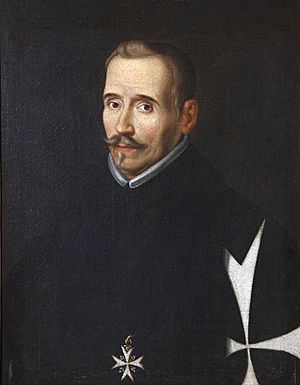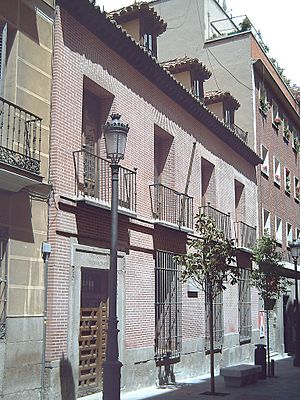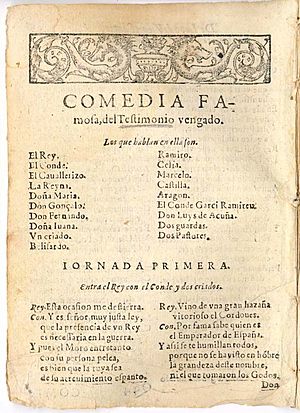Lope de Vega facts for kids
Quick facts for kids
Lope de Vega
|
|
|---|---|

Portrait of Lope de Vega
|
|
| Born | Félix Lope de Vega y Carpio 25 November 1562 Madrid, Castile |
| Died | 27 August 1635 (aged 72) Madrid, Castile |
| Occupation | Poet, playwright, novelist |
| Language | Spanish |
| Literary movement | Baroque |
| Notable works | Fuenteovejuna The Knight from Olmedo |
| Children | 15 |
| Signature | |
 |
|
Félix Lope de Vega y Carpio (25 November 1562 – 27 August 1635) was a Spanish playwright, poet, and novelist. He was a super important writer during the Spanish Golden Age of Baroque literature. His fame in Spanish writing is second only to Miguel de Cervantes.
Lope de Vega wrote more than almost anyone else in history! His friend, Cervantes, even called him "The Phoenix of Wits" and "Monster of Nature" because he wrote so much.
Lope de Vega changed Spanish theater when it was becoming super popular. He helped shape it, and with other great writers like Pedro Calderón de la Barca and Tirso de Molina, made Spanish theater amazing. He's seen as one of the best playwrights in the world, and his plays are still performed today. He was also a top poet and wrote many novels.
He wrote an incredible amount: about 3,000 poems, 3 novels, 4 short novels, 9 long poems, and around 500 plays! Even though he wrote so much, at least 80 of his plays are considered masterpieces. He was friends with writer Francisco de Quevedo but didn't get along with Juan Ruiz de Alarcón. Even famous writers like Johann Wolfgang von Goethe wished they could write as much as Lope de Vega!
Contents
Life Story of Lope de Vega
Early Life and Education
Lope de Vega Carpio was born in Madrid, Spain. His father, Félix de Vega, was an embroiderer. Not much is known about his mother, Francisca Fernández Flores. Lope later used the last name Carpio from his grandmother.
His father moved to Madrid in 1561. Lope de Vega later said his father came to Madrid because of a love story. This means Lope believed his own existence came from a dramatic love affair, which he often wrote about in his plays.
Young Lope showed his amazing talent very early. His friend and biographer, Pérez de Montalbán, said that at age five, Lope was already reading Spanish and Latin. Before he could write, he would trade his breakfast with older boys so they would write down his poems for him. By age ten, he was translating Latin poems. He wrote his first play when he was 12 years old.
His great talent led him to study with the poet and musician Vicente Espinel in Madrid. Lope always spoke highly of him. When he was 14, he studied at a Jesuit school in Madrid. He ran away from school to join a military trip to Portugal.
After that adventure, he was lucky to be taken in by the Bishop of Ávila. The Bishop saw Lope's talent and helped him enroll in the University of Alcalá. Lope had planned to become a priest like his patron. But he fell in love and realized that being single was not for him. So, he didn't get a bachelor's degree. He made a living by working as a secretary for rich people or by writing plays.
In 1583, Lope joined the Spanish Navy. He fought in the Battle of Ponta Delgada in the Azores. He served under Álvaro de Bazán, Marquis of Santa Cruz, who later became his friend. Lope would later dedicate a play to Bazán's son.
Exile and Marriage
After his time in the navy, Lope returned to Madrid and started his career as a playwright seriously. He also began a love affair with Elena Osorio. She was an actress and the daughter of a theater director. After about five years, Elena left Lope for another man. Lope then wrote very harsh things about her and her family. This led to him being jailed for libel. He was then banished from the court for eight years and from Castile for two years.
Even though he was banished, Lope de Vega was not discouraged. He took 16-year-old Isabel de Alderete y Urbina with him. She was the daughter of King Philip II's court painter. They got married on May 10, 1588, because her family pressured them.
Just a few weeks later, on May 29, Lope joined the Spanish Navy again. This was in the summer of 1588, and the Spanish Armada was about to sail against England. It's possible that joining the military was a condition set by Isabel's family. They might have wanted to get rid of him and forgive him for taking her away.
Lope was lucky again. His ship, the San Juan, was one of the few that made it back to Spain after the failed mission. By December 1588, he was back in Spain. He settled in Valencia. There, he lived with Isabel de Urbina and kept improving his plays. He regularly joined a group called the Academia de los nocturnos. In this group, he worked with other playwrights like Guillén de Castro. They refined their way of writing plays by mixing two plots into one play.
In 1590, after his two years of exile were over, he moved to Toledo. He worked for important people like Francisco de Ribera Barroso and later Antonio Álvarez de Toledo, 5th Duke of Alba. He lived in the Duke of Alba's home from 1592 to 1595. Here, he read works by Juan del Encina and improved his playwriting style. In 1594, Isabel de Urbina died after childbirth. Around this time, Lope wrote his novel La Arcadia, which was based on the Duke's household.
Later Life and Challenges
In 1595, after Isabel's death, he left the Duke's service. Eight years had passed, so he returned to Madrid. He had more love affairs and more scandals. One affair was with Antonia Trillo de Armenta, which led to another lawsuit. Another important relationship was with Micaela de Luján, an actress. She inspired many of his poems and they had four children together. She was his lover until about 1608. In 1598, he married Juana de Guardo, the daughter of a rich butcher. But he continued his relationships with other women, including Micaela.
In the 17th century, Lope's writing reached its peak. From 1607, he also worked as a secretary for the Duke of Sessa. However, after that decade, his personal life became harder. His favorite son, Carlos Félix, died. In 1612, Juana herself died during childbirth. After these sad losses, Lope gathered his remaining children to live with him. He decided to focus on Christianity. His writing in the early 1610s also became more religious. In 1614, he became a priest.
Becoming a priest did not stop his romantic relationships. He even helped his employer, the Duke, find female companions. Lope's most important and lasting relationship was with Marta de Nevares. They met in 1616 and stayed together until she died in 1632.
More sad events happened in 1635. Lope, his son with Micaela, who was also a good poet, died in a shipwreck near Venezuela. His youngest daughter, Antonia, was kidnapped and later abandoned. Lope de Vega became very ill and died of scarlet fever in Madrid on August 27 of that year.
Becoming a Priest
The time when Lope de Vega became a priest was a period of deep personal crisis for him. This was likely caused by the deaths of close family members. His religious poems, called Sacred Rhymes, and other religious works came from this time. His later poems also had a more thoughtful and philosophical tone.
On December 19, 1611, Lope was attacked but managed to escape. Juana de Guardo, his wife, was often sick. In 1612, their son Carlos Félix died from fevers. On August 13 of the next year, Juana de Guardo died while giving birth to Feliciana. All these misfortunes deeply affected Lope. On May 24, 1614, he finally decided to become a priest.
His book Sacred Rhymes, published in 1614, shows this personal crisis. In it, he writes about the body wanting to be earth and the soul wanting to be heaven. This book is very personal in its poems. It also shows his religious devotion, with poems dedicated to saints and religious art.
In 1627, he was accepted as a knight of the Order of Malta. This was a huge honor for him because he had always been interested in knightly orders. In 1603, he had written a play called El valor de Malta (The Valour of Malta) about the Order's sea battles. In his portrait by Eugenio Caxés, he is shown wearing the Order of Malta's robes.
Lope de Vega's Works
Lope's non-play works were collected and published in Spain in the 1700s. Some important ones include:
- La Arcadia (1598), a romantic story about shepherds.
- La Dragontea (1598), a long poem about Sir Francis Drake's last trip and death.
- El Isidro (1599), a poem about the life of Saint Isidore, who would become the patron saint of Madrid.
- La Hermosura de Angélica (1602), a long poem that continues the story from another famous poem, Orlando Furioso.
Lope de Vega was one of the greatest Spanish poets of his time, along with Luis de Góngora and Francisco de Quevedo. His poems about Moorish and shepherd themes were very popular in the 1580s and 1590s. In these, he often wrote about his own love affairs. In 1602, he published 200 poems in La Hermosura de Angélica. In 1604, he republished them with new material in Rimas.
In 1614, his religious poems appeared in a book called Rimas sacras, which was also a bestseller. In 1634, in another book called Rimas humanas y divinas del licenciado Tomé de Burguillos, Lope created a fake author named Tomé de Burguillos. This book is considered his best poetry work and very modern for its time.
How Lope Changed Theater
Lope was the playwright who made the three-act play, called comedia, the standard form in Spanish drama. He didn't follow the old rules of his time. In his book Arte nuevo de hacer comedias en este tiempo (1609), he explained his style. He broke the old rules about unity of action, place, and time. He said he knew the rules but refused to follow them because ordinary Spanish people didn't care about them. He famously wrote, "Let us then speak to him in the language of fools, since it is he who pays us."
Lope was proud to be a "pure-blooded" Spaniard. He believed a writer's job was to write so people could understand him. He defended the language of everyday life.
Most of his works were written quickly and on demand. Lope admitted that "more than a hundred of my comedies have taken only twenty-four hours to pass from the Muses to the boards of the theatre." His biographer said that in Toledo, Lope wrote 15 acts in 15 days, which means five plays in two weeks!
Lope's own records show that by 1604, he had written 230 three-act plays. This number grew to 483 by 1609, 800 by 1618, 1000 by 1620, and 1500 by 1632. A book written after his death said he wrote 1800 plays and over 400 shorter religious plays. Of these, we know 637 play titles, but only about 450 still exist today. Many of his plays were printed during his lifetime.
Main Ideas and Stories
It's hard to put Lope's many plays into simple categories like comedy or tragedy. His plays are mostly about exciting plots and mysteries. Lope often used history, especially Spanish history, for his stories. He wrote about many national and patriotic topics, from old kings to the history of his own time.
However, Lope's most famous plays are called capa y espada ("cloak and dagger"). These plays are mainly about love stories and honor. They often involve the petty nobility of medieval Spain.
Some of his best-known plays in this style are El perro del hortelano (The Dog in the Manger), El castigo sin venganza (Punishment without Revenge), and El maestro de danzar (The Dance Teacher).
In some plays, Lope tries to show a moral lesson. For example, in Las Flores de Don Juan, he shows that being poor is not a crime. He uses the story of two brothers to show how good, poor people can win over rich, bad people. But plays with clear morals are rare in Lope's work. Usually, his goal was to entertain and excite his audience with the plot.
In El villano en su rincón, a romantic comedy, Francis I of France gets lost during a hunt. He ends up spending the night in a woodcutter's hut. This leads to a meeting between the simple peasant and the king. The peasant refuses to even look at the king's grandness. A gentleman from the king's court tells him off, saying the king is so powerful that even fierce Turks fear him.
Lope's Lasting Impact
Before Lope, Spanish theater was not very organized. Plays sometimes had four acts, sometimes three. The way the poems were written was up to each writer. Lope adopted the popular style of drama because the Spanish public liked it. He greatly expanded it. He brought in many new ideas for plays, such as stories from the Bible, old myths, the lives of the saints, ancient history, Spanish history, medieval legends, Italian novels, current events, and everyday Spanish life in the 1600s.
Before Lope, playwrights only briefly described characters. Lope de Vega observed people more closely and described real character types. He gave them language and clothes that fit their place in society. The old plays were often clumsy in their poetry. Lope brought order to all forms of national poetry, from old romance poems to lyrical styles from Italy. He wrote that those who came after him only had to follow the path he had opened.
Not all poets were impressed with Lope's new ideas. The Spanish poet Pedro de Torres Rámila wrote a Latin satire called Spongia (1617). Torres personally attacked Lope's religious plays and tried to ruin his reputation. But this plan failed. The public reacted very negatively to Spongia. Many scholars and poets defended Lope de Vega and wrote responses against Torres.
List of Important Works
Plays
Here are some of Lope de Vega's most famous plays:
- El maestro de danzar (1594) (The Dancing Master)
- Los locos de Valencia (Madness in Valencia)
- El acero de Madrid (The Steel of Madrid)
- El perro del Hortelano (The Gardener's Dog)
- La viuda valenciana (The Valencian Widow)
- Peribáñez y el comendador de Ocaña
- Fuenteovejuna
- El anzuelo de Fenisa (Fenisa's Hook)
- Mujeres y criados (Women and Servants)
- El mejor alcalde, el Rey (The Best Mayor, The King)
- El Nuevo Mundo descubierto por Cristóbal Colón (The New World Discovered by Christopher Columbus)
- El caballero de Olmedo (The Knight from Olmedo)
- La dama boba (The Stupid Lady)
- El castigo sin venganza (Punishment Without Revenge)
- Las bizarrías de Belisa (Belisa's Oddities)
In January 2023, a play called La francesa Laura (The Frenchwoman Laura) was found to be another comedy by Lope de Vega. This was discovered with the help of artificial intelligence. It's thought to be a late work from 1628 to 1630. This is because it spoke well of France, which fit the good relationship between Spain and France during the Thirty Years' War. Later, historians confirmed what the AI found.
Opera
- La selva sin amor (18 December 1627) (The Lovelorn Forest), which was the first Spanish opera.
Epic and Lyrical Poems
- La Dragontea (1598) ("Drake the Pirate")
- El Isidro (1599) ("Isidro")
- La hermosura de Angélica (1602) ("The Beauty of Angelica")
- Rimas (1602) ("Rhymes")
- Arte nuevo de hacer comedias (1609) (New Art of Writing Plays)
- Jerusalén conquistada (1609) (Jerusalem Conquered)
- Rimas sacras (1614) ("Sacred Rhymes")
- La Filomena (1621)
- La Circe (1624)
- El laurel de Apolo (1630) (Apollo's Laurel)
- La Gatomaquia (1634) (The Cat Battle)
- Rimas humanas y divinas del licenciado Tomé de Burguillos (1634) ("Human and Divine Rhymes of Licentiate Tomé de Burguillos")
Prose Stories
- Arcadia (published 1598) (The Arcadia), a shepherd romance with poems.
- El peregrino en su patria (published 1604) (The Pilgrim in his Own Country), a story like old Byzantine novels.
- Pastores de Belen : prosas y versos divinos (published 1614) (Shepherds of Bethlehem: Divine Prose and Verses)
- Novelas a Marcia Leonarda (Novels for Marcia Leonarda), a collection of short novels:
- Las fortunas de Diana (published 1621) (Diana's Fortunes)
- La desdicha por la honra (published 1624) (Misfortune for Honor)
- La más prudente venganza (published 1624) (The Most Prudent Revenge)
- Guzmán el Bravo (published 1624) (Guzmán the Brave)
- La Dorotea (published 1632)
Tributes to Lope de Vega
A town in Northern Samar in the Philippines was named after Lope de Vega in 1980.
A street in the Santa Cruz district of Manila, Philippines, is also named after him.
On November 25, 2017, Google celebrated his 455th birthday with a special Google Doodle.
Images for kids
See also
 In Spanish: Lope de Vega para niños
In Spanish: Lope de Vega para niños





